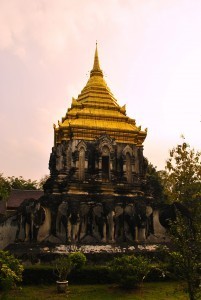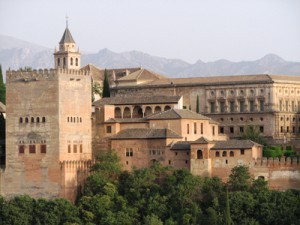Lisa Niver's Blog: We Said Go Travel, page 408
March 20, 2014
Watu Ondo Waterfalls in Indonesia
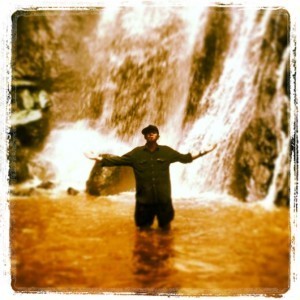 Twin bridges to twin waterfalls. A waterfall I encountered by luck makes the title of this piece I want to share with all travelers. My name is James HS Cameron, but like all people I know, you may call me Jem (gem stone). Growing up as a child I already figured out to have a desk job in an office is not a life I would live. Personally, there is something about cities which makes me feel claustrophobic and paranoid, the buildings and roads close in and seems too narrow for me to see freedom on earth.
Twin bridges to twin waterfalls. A waterfall I encountered by luck makes the title of this piece I want to share with all travelers. My name is James HS Cameron, but like all people I know, you may call me Jem (gem stone). Growing up as a child I already figured out to have a desk job in an office is not a life I would live. Personally, there is something about cities which makes me feel claustrophobic and paranoid, the buildings and roads close in and seems too narrow for me to see freedom on earth.
I found the “Watu Ondo” waterfalls by coincidence; a beautiful gem not many people are aware of, including locals. Located near a public hot spring in a town named “Batu” (rock) I found the waterfalls when one of my good friends from United Kingdom, came to visit me in Indonesia. His name is Gordon also known as “Gee” and works in the UK as a tree surgeon/tree doctor. I became his local guide here to show him the country, took him to the area to show him the rain forest for wildlife and tree spotting. The area is under protection of the national department of forestry and wildlife.
The hot spring area is famous for fermented forbidden rice (black/purple rice), so we had a swim and decided to find something to warm our bellies. Travelers will be able to find the fermented rice in the hot spring area but usually already in a liquid form and not fermented long enough to make our bellies feel warmer. I decided to take Gee to one of our spots, further up the main road passing the hot springs through the rain forest, travelers will find twin bridges, the first bridge passing over a canyon. We parked up my vespa in between the two bridges to purchase from a rice seller; the exotic snack and also a liter of the liquid form. Whilst sitting on the bridge overlooking the river flowing through the canyon, we had our snack and drank, taking pictures. When we were sitting peacefully, the both of us heard the sound of nature; of water dropping in our ears, at first we thought it was the river underneath us but soon realized it would only be the twin waterfalls nearby, unseen from the bridges but not unheard. We left the area because we needed to water the plants in the backyard of the house, but I had a gut feeling to go back. We already visited all the main waterfalls in Batu, but we almost missed out on my favorite. The feeling never left me and on instinct we went back to the area with the mission to find the sound, passing the bridges about 50 meters further ahead there is a clearing on the right, we almost missed it!
After parking the bike there are steps made out of stones leading down, these stone steps are named after the waterfall. As travelers go down the steps you will see immaculate views of nature between rest points, only 5-10 minutes to get to the waterfall the final resting point is the best. Gee and myself spent some time awestruck at the view, turned out to be two twin waterfalls in perfect view of each other! Each with a shallow pool under each waterfall. As we enjoyed the view, we noticed there was a romantic local couple and we did not want to intrude their peace. We waited whilst having our fermented forbidden rice and went down when they left. We were literally the only ones there and spent almost a day there enjoying the nature. The beauty you will get is indescribable. A place a traveler must witness themselves, because no words can explain it.
Watu Ondo is now one of my favorite spots on earth and yes, I see freedom there. You might be lucky to find a Javanese hawk flying around or the friendly, peaceful Macaque monkeys enjoying their habitat.
My entry goes out to all travelers and those who daydream about leading a life of adventure but is working in an office in the city. There are certain moments in life where your instincts tell you something, but is put to one side and then forgotten. The feeling you get is nature calling and talking from personal experience, this is where you will find magic in life, not through coincidence or luck but through this calling which might take you to unexpected moments of beauty and adventure where you may encounter romance, friendship and experience. In my own words; age and time is just a bunch of numbers, you are as old as you feel and you have all the time in the world. So go travel and enjoy your life.
About the Author: James HS Cameron is co-founder and CEO of Archipelago Encounter. Born in Indonesia on 14.11.1989 from an Indonesian mother and British father. His final dream in life is to be one of the best tour guides for Indonesia and to save up for a Phinisi schooner that will take him and travelers to sail all 17,000 islands of Indonesia.
Thank you for reading and commenting. Please enter our next Travel Writing competition and tell your story.
The post Watu Ondo Waterfalls in Indonesia appeared first on We Said Go Travel.
March 19, 2014
Los Angeles: Just being is enough
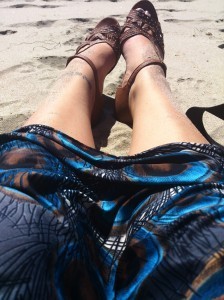 Do you still remember that place you have dreamed of since you were young? Have you visited already? Are new places filling your dreams during your waking life? Sometimes it does not matter what you do when you are at that specific place you dreamed of, just because you made it there. You took a plane, a train, a boat, and you fulfilled your dream. Time then becomes yours because you don’t need anything to happen to be happy besides just being. Your holiday is made from the get go. This happened to me in Los Angeles, the city I have dreamed of going since I was 17.
Do you still remember that place you have dreamed of since you were young? Have you visited already? Are new places filling your dreams during your waking life? Sometimes it does not matter what you do when you are at that specific place you dreamed of, just because you made it there. You took a plane, a train, a boat, and you fulfilled your dream. Time then becomes yours because you don’t need anything to happen to be happy besides just being. Your holiday is made from the get go. This happened to me in Los Angeles, the city I have dreamed of going since I was 17.
Of course, I planned what I wanted to see in LA and, of course, I did not get round to see everything. Sometimes I felt a sense of sadness just because I had to leave a certain place, like the Getty center or the Griffith observatory: Los Angeles is not next door and the plane ticket is not nearly as cheap as I need it to be, but there are so many amazing places I’d love to spend more time. However, after that sudden moment of sadness, I also felt an incredible joy building in my body. I realized: ‘I am here and no one can stop me from returning’, ’I am here, and whoever said that would never happen was wrong’, ‘I am here and I still cannot believe I am really here’. I took everything in, the big things but also the seemingly very small. I engaged all my senses. Yes, I saw the Hollywood sign, yes, I walked in Beverly Hills, but I also watched pelicans nibble on the fish that fishermen dropped at the pier in Santa Monica. I went to Muscle beach but also sat down to watch a friendly game of basketball while drinking a Slurpee. I looked at all the stars and prints at Man’s Chinese theatre, but I also had conversations with people who will never even own a television set. I read on the beach and I swam in the ocean, I felt as if I belonged there at that spot and at that moment.
Los Angeles is often portrayed as a city full of glitz and glamour and plastic fantastic. Of course, if you wish to find that part, you will find that part. I, on the other hand, felt that LA is the place where everyone, no matter how big, small, old, or young, can walk around without instantly being judged for who they are: I saw a homeless man talking to a, seemingly, rich woman on a terrace of a fancy restaurant. They were engaged in a deep discussion about life. I saw genuine beauty not only on the outside but also on the inside because people did not feel the need to hide themselves for fear of looking out of the ordinary. They were human beings and just that fact was enough to interact: Being was enough. I saw people on the bus and metro from all walks of life talking and helping one another instead of ignoring each other. And I, someone who never talks to strangers, joined in. I took the time to understand the people I was talking to and I tried to ‘understand’ the city by just breathing in its vibe. I learned to walk into a situation without any prejudice because I was genuinely interested in what people had to tell. I learned that everybody and every city has a story and that story deserves my time. Whilst at the same time I have to kick my time and plans to the curb and just be inside the moment with every bone in my body and with all my heart.
About the Author: Joyce Vos is an independent writer in the blogging, content writing, and translation field. Creative writing, travelling, and drawing/painting are things she is passionate about. One of her many dreams is travelling as much as she can.
Thank you for reading and commenting. Please enter our next Travel Writing competition and tell your story.
The post Los Angeles: Just being is enough appeared first on We Said Go Travel.
“Mai pen rai, take it easy!” in Thailand
It is 7 o’clock in the morning, the alarm clock plays an Italian song and I point my eyes towards a corner of the window on my left: the sun reflects the shape of the grid on the wall. I remain in bed another couple of minutes to observe this soft light.
Short after I descend the stairs heading to my bicycle and I ride to the nearby market. The sun this time dazzles me, I always forget the glasses, and when I enter the dark hall I am blinded for few seconds. Luckily, I know by heart where my breakfast place stands and I am able to reach it anyways. While I wait for my bowl of fresh fruit I observe the market waking up: some women cut the meat, a man fills the containers with rice and Tip slices bananas, mangos and papayas with admirable skill.
When I am back in my room, before going to my daily yoga ball practice, I have time to check my emails so that when I return I can directly work on my writing and editing schedule.
While I cycle to the gym I blend in with the locals going to work and school. Despite the traffic no one seems to be in a hurry, nobody is rude or frenetic, people are even able to smile at this early hour. Actually, I notice that everybody smiles all the time, even in the most stressful situation and in markets or festivals colours, smells and serenity prevail over chaos. This lack of stress and general sense of calmness has been Chiang Mai’s most unexpected revelation.
I first realized this during one of my lunch breaks, which are also my favourite moments of the day. I sat with my book open on the table but I was not really reading, I was rather immersed in my thoughts, which were bringing me back to my lunches in Norway when I have a sandwich or sometimes only a bite of it while running from the supermarket to the office. Now, I have the privilege to sit down, greet the people around me and even read. Unconsciously, I have already absorbed the laid-back approach that characterizes so much Thai people and the way they lead their lives.
This is why short after lunch, when the stomach is full and the temperature is hot, I am able to simply acknowledge that I have less energy and so I keep on working at a lower pace. However, sometimes it just does not feel right to sit in front of a computer: I can’t write, I can’t focus, I need to move. Instead of struggling with this situation I put a scarf in my bag, I take my note book and my camera and I go out.
On this occasion I would go to a park but in Chiang Mai it is easier to find a temple than a green area. When I had just arrived I decided not to visit all the temples in the first days but instead to explore them one by one during my stay here. So this is where I sneak some afternoons and as soon as I pass the threshold that separates the street from the sanctuary that general sense of calmness that characterizes the city is amplified.
I look at the day light, I set the right options of my camera, I wander and shoot: the details of the statues, the dragons at the beginning of the stairs, the roofs made of multiple layers, every piece tells a story.
Usually, around the stupa there seems to be another dimension where time does not exist, here I stop a little longer wandering if this is the source of the peacefulness that embraces this place.
About the author: Jessica Michele Garcia is a freelance writer graduated in Translation and Communication Sciences and in Freelance Journalism. I also work as tour agent and tour guide in Norway every summer. My inspiration are nature, travels and spontaneous human beings.
Thank you for reading and commenting. Please enter our next Travel Writing competition and tell your story.
The post “Mai pen rai, take it easy!” in Thailand appeared first on We Said Go Travel.
Charm of Chiang Rai, Thailand
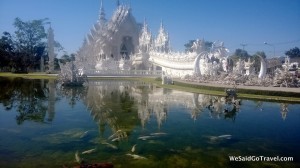 For our first visit to Chiang Rai, I searched on Asiarooms.com for a place with a pool. I found the Mantrini, which was recently featured in the magazine, Chiva and shared the Chiang Rai Charm of the property. While we stayed there, we enjoyed being next door to Centre Plaza and seeing a brand new film in the state of the art theater. The room was comfortable and well appointed with a cozy bed and pretty pink pillows. The bathroom had a sunken tub with a powerful shower and many signs about how to care for the environment. I liked the art in our room and throughout the hallways. Breakfast was a vast buffet and included any type of eggs and many Thai specialties.
For our first visit to Chiang Rai, I searched on Asiarooms.com for a place with a pool. I found the Mantrini, which was recently featured in the magazine, Chiva and shared the Chiang Rai Charm of the property. While we stayed there, we enjoyed being next door to Centre Plaza and seeing a brand new film in the state of the art theater. The room was comfortable and well appointed with a cozy bed and pretty pink pillows. The bathroom had a sunken tub with a powerful shower and many signs about how to care for the environment. I liked the art in our room and throughout the hallways. Breakfast was a vast buffet and included any type of eggs and many Thai specialties.
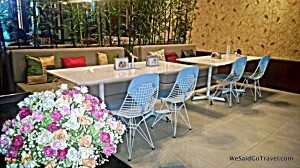 On our second night, an anniversary party filled the pool area and we were treated to the wonderful party music during the early evening. It was like we were part of the festivities. The staff was welcoming, knowledgeable and assisted us with our onward travel plans. They helped us find the local bus to visit the White Temple or Wat Rong Khun. This mirror laden Buddhist temple was built in 1997 and designed by Chalermchai Kositpipat. It is still under construction as more sections are being added and the paining of the inner sanctuary is on going. I did like the art, which included designs of superman, star wars and the matrix. We did not visit the Black House we will have to see it on our next visit.
On our second night, an anniversary party filled the pool area and we were treated to the wonderful party music during the early evening. It was like we were part of the festivities. The staff was welcoming, knowledgeable and assisted us with our onward travel plans. They helped us find the local bus to visit the White Temple or Wat Rong Khun. This mirror laden Buddhist temple was built in 1997 and designed by Chalermchai Kositpipat. It is still under construction as more sections are being added and the paining of the inner sanctuary is on going. I did like the art, which included designs of superman, star wars and the matrix. We did not visit the Black House we will have to see it on our next visit.
While in Chiang Rai, I highly recommend a visit to the clocktower! At 8pm and 9pm, there is a color and light show. You can see it in our video. George says, “It is the best clock tower in the whole world!” I really enjoyed the spectacle and the night market. My favorite café is Destiny located only half a block from the clock tower.
Visiting many of the Wats around town was interesting and I was surprised how different each one is from the next. Both George and I liked Wat Phra Kaew the best of all that we visited. The Phra Yok Chianrai (Jade Buddha) is housed there and made from Canadian jade. There is a new hall under construction. I also like Wat Mung Muang and the Phra Sang Kad Jai who is one of the Buddhist saints in the courtyard.
I can highly recommend the Hill Tribe Museum. We watched the informative video and learned about the many different peoples of Thailand. It was sad to learn about the Karen Tribe who are called Long Neck due to their golden bangles that stretch their necks. They are not Thai but Burmese refugees and the Hill Tribe museum and tour company located there say repeatedly do not visit a human zoo. The refugees are not being treated properly and many do have their papers withheld by the “landlords” of the village where they are nearly held captive.
We also enjoyed a visit to Chiang Saen, Mai Sai and the Burmese border. After our stay in Chiang Rai, we were off to Chiang Mai for music on the riverside and wandering inside the Old City Walls. Wherever you choose to visit in Thailand, I am certain you will enjoy tasty treats and meet lovely new friends. Let us know what special places you find, maybe we will go there on our next visit!
Author’s Note: We thank AsiaRooms and the Mantrini for our visit! The opinions are our own and we really enjoyed Chiang Rai and the hotel!
The post Charm of Chiang Rai, Thailand appeared first on We Said Go Travel.
The Sweetness of Doing Nothing in Australia
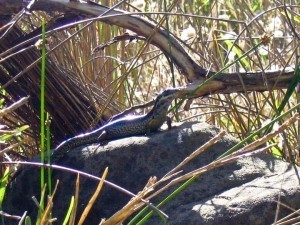 Growing up on the Canadian prairies, the first time I saw the ocean was when I was 14 years old, on a family trip to Mexico. I still remember wading out into the clear, endless water, feeling the fine sand float around my feet as I sunk into it, surprised at how cold it was when the sun above was burning me to a crisp. And staring, spellbound. I’ve never felt more at peace or been more inspired to see every inch of the world as I was in that moment. So maybe it makes perfect sense that of all the different places I’ve lived abroad, the majority have been near the sea. Perhaps I’ve always subconsciously chosen to live near it, in an effort to recreate this feeling.
Growing up on the Canadian prairies, the first time I saw the ocean was when I was 14 years old, on a family trip to Mexico. I still remember wading out into the clear, endless water, feeling the fine sand float around my feet as I sunk into it, surprised at how cold it was when the sun above was burning me to a crisp. And staring, spellbound. I’ve never felt more at peace or been more inspired to see every inch of the world as I was in that moment. So maybe it makes perfect sense that of all the different places I’ve lived abroad, the majority have been near the sea. Perhaps I’ve always subconsciously chosen to live near it, in an effort to recreate this feeling.
As with most people, there’s something mysterious to me about that great expanse of water, some quality that draws me to it, like a moth to a flame. I unhesitatingly answer its call. There’s a calmness and tranquility to it, but there’s also a quiet danger, of the unspeakable horrors it can give birth to. No matter how many years I spend cohabiting with it, it will always remain a surreal mystery to me.
The first time I moved abroad six years after first setting my eyes on it, I was ecstatic to learn that my placement with the farm exchange program I was on was right near the beach. Of all the beaches I’ve been to since, the one that stands out most in my mind is this one, in Port Campbell, Australia, a tiny little stretch of paradise a short drive away from my new home. I could smell the sea from the farm I was on, a great feat to be able to smell something else besides the manure of 200 dairy cows and silage. And if I listened closely, I could hear it in the dead of night. I couldn’t wait each day to finish milking and be able to jump in the shower in time for my friends to pick me up so we could drive down and spend time there. How lucky we were to be living right by the 12 Apostles, one of the most popular tourist sites in the country, yet all we cared about was that beach. That’s how you know a new country has become home: when how you spend your free time is similar to the locals.
This is the beach where I saw my first shooting star, while sleeping under the velvet sky on my way to a New Years Festival, waking up to a lizard sunbathing on a rock beside my head. This is the beach where I sat in a car one sweltering summer night in December, sharing a cheap bottle of wine with my friends, and watching the lightning dance across the sky in our own personal performance, illuminating the waves crashing against the shore for a split second before leaving us in darkness again. Even when the night is ink black and all is calm, you can still feel its presence. You can still hear the waves gently lapping at the shore, the smell of salt sticks in your nostrils, the taste of spray on your tongue.
This beach was a place where I could happily spend hours, whiling the days away, barefoot and without a care in the world, without feeling like I needed to do more, or see more. Some days, I would lie on the beach and do nothing but sigh. Not out of boredom, but out of pure happiness, as all the stress and worry escaped from my body. Dolce far niente, the sweetness of doing nothing. On this beach, I didn’t have a care in the world. It was on this beach that I found myself, which I can see only in hindsight. I remember closing my eyes and drifting away, planning all the places I would spend a lifetime in. I could see anything, be anyone. It was my first taste of freedom.
Nearly a decade has passed since I’ve been on that beach. Over the past few years, while living in Japan and getting caught up in the rat race, I noticed the stress getting to me. I worried more about every little thing, cared about money far more than I liked, and never took any time to relax. I was no longer that eccentric, carefree, tanned gypsy girl who never wore shoes and had sandy dreadlocks. At least not on the outside. But once I dug her up and started spending every moment I could on the beach, a mere five minute walk from my apartment, we were reunited.
About the Author: Tzigane Ludwig graduated with a Bachelor of Science in Agriculture which she’s never used and instead followed the meaning of my name (‘gypsy’ in Hungarian). She’s milked cows in Australia, worked as a carnie in Scotland, harvested potatoes in Switzerland, and taught English in Japan. She’s currently back in Canada, working on a degree in International Development.
Thank you for reading and commenting. Please enter our next Travel Writing competition and tell your story.
The post The Sweetness of Doing Nothing in Australia appeared first on We Said Go Travel.
March 18, 2014
Echar Los Perros (Release the Dogs) in Colombia
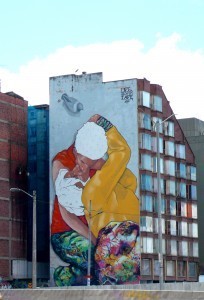 We spend our lives making safe choices: insurance policies, retirement funds, dual-side airbags. Then we travel.
We spend our lives making safe choices: insurance policies, retirement funds, dual-side airbags. Then we travel.
Only as our finger hovers over “Purchase” on the airline website are we free. In that moment, we haven’t yet determined when we should depart for the airport. We haven’t compared hotel reviews or fretted about connections in Dallas or Amsterdam. The world is ripe for adventure, and we are courageous explorers, savvy and open to change.
Then we plan.
We request advice. We read travel books. We map our journeys from the first moment to the last, stringing sights like a pearl necklace: churches and museums, parks and promenades. We anticipate —no, we insure— against the unexpected, insulating ourselves from the very freedom we sought when we were inspired to travel.
Thankfully, the world has other aims for us. We know this. Floating beneath our intent for control, our subconscious minds are drawn to navigate the inky network of adventure and surprise. Part of us hopes to be whisked away, tested by unpredictable circumstances, because those moments are what make us feel alive.
Journeys like these bring us to strange, bustling streets bursting with storefronts painted in fuchsia and robin’s egg blue, whose historic palimpsest chips away at the hardened walls of our hearts. This is no quaint European vacation whose transit strikes leave time for cappuccino or whose closed museums yield afternoons at the edges of the Seine. This is La Candelaria, the oldest neighborhood in Bogotá, Colombia, whose sun-drowsed stoops abut chaotic, stony El Centro.
Unlike Florence, nothing stops in Bogotá. Not the abuelitas selling mobile phone minutes, or the flocks of fruit vendors or the toothless old men shaking plastic cups of change outside La Iglesia de San Francisco.
Calles and carreras are easy to confuse. One minute the route is clear, then suddenly the shops become seedier, the faces attuned to the gringa, the freckled brunette whose handbag is full of American promise. A homeless woman calls to her in Spanish as she steps through the square to the sound of makeshift drums beaten by a teenage boy near the fountain.
A la izquierda, a la derecha, she thinks as she turns left and right. She’s following the spire of the yellow church, a landmark her friend said would guide her. From all directions, it’s just out of reach. Her heart flutters when the guard at the ministry of finance doesn’t understand her query, nor she his response. She stops to ask one woman and then another with no luck; she wonders if she’ll find her way.
The gringa pauses in a colonnade to check the map, unable to find her quarry, a crisp white building where a trove of chubby Botero paintings and sculptures await, cherubic nudes blushing not for themselves but the viewers who giggle at their plump nakedness. She turns around, crossing the square again, shooing the wares they press into her hands and the flyers they flutter in her face. She pushes through the crowds gently, as if they were her mother’s beaded curtains.
The streetlight turns and she stops short, saving herself from death by taxi, stumbling back atop the curb. She looks up for the first time in hours, and suddenly, there is the Museo del Oro where she began. Her bearings regained, she abandons her search for Botero and walks instead to the base of Monserrate —this, she can find— and boards the funicular.
Her heart beats in her throat as the old cable car hovers parallel with the mountain all the way to the top where a church glows green against the falling dusk. In this aerie pilgrimage, her friend awaits, arms outstretched. Nico has sold her fresh fruit every morning, each more strange and delicious than the other. When she sees him, her mission is complete.
At home, she’s never relieved, but here at 10,000 feet where planes fly, she feels unweighted. She tells him about the graffiti murals and the special gold room at the Museo del Oro. She doesn’t mention the elusive Botero.
Nico’s eyes are as brown as the coffee at his family’s market. The taste of his mouth as they kiss hello is tangy and sweet, like the lulo fruit he blended for her into frothy jugo. The Colombian food is still new, like the toasted corn arepas and steamy infusions of herbs and flowers they drink in the afternoons.
“Echar los perros,” he whispers in her ear as she leans forward over the stone parapet, dizzied by the winds blowing up from the Bogotá savannah. “Release the dogs,” he translates when she tilts her head. Soon, she comes to learn its meaning. Let’s throw caution to the wind. Let’s be together. Let’s try. Let’s go.
About the Author: A Detroit native and Seattle resident, Gabriela Denise Frank is the author of “CivitaVeritas: An Italian Fellowship Journey.”
Thank you for reading and commenting. Please enter our next Travel Writing competition and tell your story.
The post Echar Los Perros (Release the Dogs) in Colombia appeared first on We Said Go Travel.
The Water Palace in Granada
When I was a student, I spent a year in France teaching English as part of my degree course. As chance would have it, I met a Spaniard called Jesús who I spent a lot of time with. He came from Cádiz , which is a coastal city in the southern region of Spain called Andalusia. He went to university in Granada, and I visited him on a few occasions after my time in France had ended.
Secretly, I was more interested in Spain the country than in him, but I was more than happy for him to show me around his native region, which, he proudly told me, is the most unique in the whole of Europe. He thought this because of the landscape and climate. In Andalusia, the heat is intense in the summer and there are palm trees and dry bushes nestling in a desert like, mountainous landscape. Compared to the luscious green trees and fresher climate of most of the northern European countries, Jesús thought that Andalusia was, like he imagined himself, a bit special.
One of the most unique parts of Granada is the Alhambra, which is a palace built by the Moors in the 11th Century. Its walls are peach colored and the fortress is set on a hill above the city. Aside from its marvelous architecture, the one aspect of the Alhambra that struck me was its fountains and water tracts. The Moors were an intelligent people, and, aware that southern Spain is a very dry and hot region, they constructed waterways in the palace that wisely made use of all the rain water that infrequently fell. Not a drop was wasted.
After visiting the palace, I spent a few days with Jesús and his family who were very welcoming despite my basic Spanish language skills. I remember brushing my teeth one morning and Jesús’ mother, a tall, wiry, blonde woman called Lola which is short for ‘Dolores’, ran into the bathroom and said something to me in Spanish. When I brush my teeth I always keep the cold water tap running – I’m from Ireland and water shortage is hardly ever a problem there. However in Lola’s eyes, it was a terrible waste of water, and she promptly turned the tap off while I apologized to her with toothpaste running down my chin. She had been brought up in the Franco era of Spain which was a frugal time for all concerned and she hated waste of any sort. Jesús told me that his grandmother used to make a meal of stale bread by soaking it in sweet hot coffee. I tried it and it was actually quite nice.
As I returned home on the plane, I remember looking out on the Sierra Nevada, the mountain range surrounding Grenada, and thinking how admirable their “waste not want not” attitude to life was. In an age where rampant consumerism in the western world is so disgusting, especially in the UK, it made me realize that to make the best of what you have is no mean thing, no pun intended. The Moors lacked water, but they found a way to keep the little they had abundantly flowing by constructing an intricate hydraulic system that was not only ingenious, but beautiful.
That visit to the Alhambra was one of the last times I spent with Jesús as his girlfriend. We have gone our separate ways since and I have not heart from him for a long time now. But I’ll treasure everything that I learned from him and his way of life – his guitar playing, his humor, his making the best of what he had and living with a special joy that I sorely needed having grown up in sectarian-torn Northern Ireland. Perhaps we all could learn a little from the Moors by celebrating what we do have, instead of mourning what we seemingly lack.
About the author: Catherine Robinson read French and German at St Hilda’s College, Oxford University, England. She is from Larne, Northern Ireland.
Thank you for reading and commenting. Please enter our next Travel Writing competition and tell your story.
The post The Water Palace in Granada appeared first on We Said Go Travel.
The Great Mid West, Australia
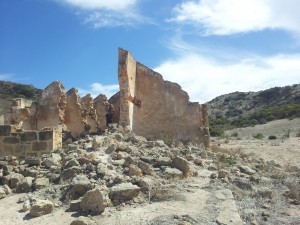 The hot wind lashed against my face as the bike raced up the wide open highway. I’d been in fifth gear for 30 miles now, and the radiating engine singed the hairs on my leg. We were hoping to reach Kalbarri by nightfall, but we were already under a ripe mango sky.
The hot wind lashed against my face as the bike raced up the wide open highway. I’d been in fifth gear for 30 miles now, and the radiating engine singed the hairs on my leg. We were hoping to reach Kalbarri by nightfall, but we were already under a ripe mango sky.
Anna and I had been riding for two days now, a few hundred miles up Indian Ocean Drive from Perth and then the North West Coastal Highway from Geraldton, a coastal city of 35,000. We left base with a sleeping bag, a tent, a loaf of bread, some Vegemite, and a hammer, all crammed into a 40-litre luggage rack on the back of a black sports tourer. It was our escape, a few days to ditch the city and find some time for the stars.
As we sped along the West Australian coastline, we scanned the fields for any movement – a kangaroo scratching with its hind legs, or a tree blowing in the wind, but there was only stillness. Stillness like you’ve never seen it, as if the world here was just a billion year old oil painting, left to dry and crack under the terror of the Australian sun.
We’d stopped in at Geraldton the night before for a rest – pitched up the two-man and listened to the cargo ships on the docks until the early hours of the morning. When the sun started blaring through the mesh windows, we took a couple of hours to splash and dive in the coolness of the crystal blue Indian Ocean – swimming as far out as we would dare, and then swimming back.
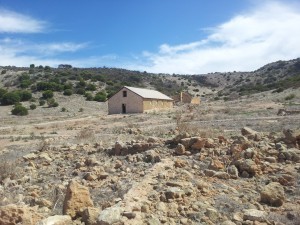
By the afternoon, the morning seemed like days ago, as the endless unchanging road played around with the hours. All you can do on those long straight stretches is think, so you try to think about where you’re going to and not where you’ve come from.
The fuel gauge was reading a quarter full, so we pulled in to fill up at a service station in Northhampton – a historical town, originally named The Mines. Anna climbed down and took off her helmet. “How’s the ride?” I asked. “Long,” she replied. I handed a fifty to the attendant and he gave me back ten-something change. “Many customers?” I asked. “The usual.”
We sped on down the road, passing one or two cars every half hour. I decided to take a detour through Port Gregory, a quaint fishing town with a population of 46. Hutt Lagoon, a salt lake just outside town, had dried up, turning the lake into miles and miles of treadable pink salt. Some tourists pulled up, and we helped take a couple of photos of them walking on the crystalline flats.
Anna waved goodbye to them as I shifted into second, watching the red West Australian sun disappear in the rear vision mirror. I pulled back my sleeve and looked down at my watch – 35 miles to go.
The post The Great Mid West, Australia appeared first on We Said Go Travel.
Monsoon Magic in India
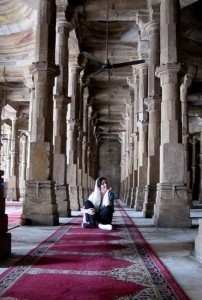 I have been warned about peacocks going crazy during monsoon season, but on this early June morning, I could not have imagined a louder or stranger sound as the one that awakes me. Soon enough, the door opens, and my host, the beloved grandmother of a dear college friend, urges me to my feet with her usually energetic “Chalo! Chalo!”, which I have come to use all too often myself during my stay in India. I ask Dadi, as we call her, about the peacocks. “Yes, they’re walking on the rooftops, waiting for the first rain. We’ll have it any moment now.” Stumbling down the hallway towards my breakfast chapati, I wonder if I should welcome the rain – after all, wouldn’t it turn the dusty roads around the house in muddy traps? The clothes which stick to me with renewed stubbornness every day since I arrived beg to differ.
I have been warned about peacocks going crazy during monsoon season, but on this early June morning, I could not have imagined a louder or stranger sound as the one that awakes me. Soon enough, the door opens, and my host, the beloved grandmother of a dear college friend, urges me to my feet with her usually energetic “Chalo! Chalo!”, which I have come to use all too often myself during my stay in India. I ask Dadi, as we call her, about the peacocks. “Yes, they’re walking on the rooftops, waiting for the first rain. We’ll have it any moment now.” Stumbling down the hallway towards my breakfast chapati, I wonder if I should welcome the rain – after all, wouldn’t it turn the dusty roads around the house in muddy traps? The clothes which stick to me with renewed stubbornness every day since I arrived beg to differ.
“Jaldi, baju sejao!” – I find myself screaming to the rickshaw driver as we make our way through Manek Chowk, the busiest market in Ahmedabad, where I spent an obscene amount of time during my first days in the city, hunting for antiques and delicious street food (I once entered an ad-hoc contest for eating pani puri, and became an honorary Indian after winning with my 15 swallowed puris). The India of overwhelming smells, colors and sounds, a kaleidoscope of beliefs and experiences, envelops me like a beautifully embroidered sari. I close my eyes, in an attempt to still, forever, the image and the feeling in the innermost corners of my being, where they would be safe for the ages. In the flight of the rickshaw, I pass Sidi Saiyed, where the sun splits its smile through the intricately carved stone windows, and see the steps leading to another mosque of great beauty, Jama Masjid, where the soft murmuring accompanies one’s echoing footsteps across the courtyard.
Finally arriving at the Sabarmati Ashram, the house of Mahatma Gandhi for about twelve years, I kick off my dusty sandals and stop to marvel at the tranquil Sabarmati River glimmering through the trees. I imagine the Mahatma bidding farewell to his beloved Ashram in 1930, to embark on the Salt Satyagraha. This place, as Ahmedabad itself, was a cradle of the non-violent movement for India’s independence, and I feel small and insignificant in the middle of all this history. As I ask for directions, I address men and women with “auntie” and “uncle”, as everyone does – it goes to show that in India, you become part of a family of many. Here, they take the “every stranger is a friend you haven’t met yet” to a whole new level. Here, every stranger is a relative. The Ashram is full of Mahatma’s spirit – a quiet, settled, controlled understanding of the world. I expect his statue to open its eyes at any moment and step off the pedestal to talk to me about patience, good and virtue. I bow to Gandhi’s marble representation, as if leaving an old, dear friend, and make my way back to my rickshaw.
My last stop before heading to my host’s house is the Charanagar slum, an example of the real India that tourists blinded by shiny temples and well-stocked hotels do not get to know. As usual, it is in the slums you will find reality pulsating with all its might – the oft-ignored, but no less genuine heart of the city. I stand barefoot under a ceiling of Mogra flowers in someone’s front courtyard, as a hidden speaker blasts traditional Indian music and prayers. It dawns on me that the music of India is the articulation of the rhythm of its life. In no other place do sounds amount to such faithful a description of destiny and hope. People congregate at the local bakery, kids pass on bikes, in their school uniforms and rickshaws wait, parked in all directions, while their drivers chat in the fading light. Women in saris stroll leisurely by, a cow or two make a lazy appearance, and dogs chase each other up and down the unpaved road. I note in my travel journal: “India is not at all reluctant to open itself to you, but it is overwhelming. And the more it gives, the more you realize how much more remains to be discovered.”
“Why do you want to put me into a box?” I reply to my host’s granddaughter’s question about my identity. “Let’s remain as we are, two strangers in a world of possibility.” And I instantly recognize that inability to be boxed, that power to shake all convention and description, as defining India itself. We suddenly extend our arms out of the balcony, under the first rain of the season. The refreshed air is full of wonderful fragrances, clarity and youth, and India reinvents itself once more. The world seems unapologetically beautiful for the first time in a long while.
About the Author: Adriana Popa graduated with High Honors from Swarthmore College in May 2012, and has lived, worked and studied on three continents. She is currently buying her time in the “real world” before returning to academia (Columbia University, for graduate school). She finds inspiration in the framed message hanging over her desk: “Live, write, travel”.
Thank you for reading and commenting. Please enter our next Travel Writing competition and tell your story.
The post Monsoon Magic in India appeared first on We Said Go Travel.
March 17, 2014
Embracing Serendipity in New Zealand
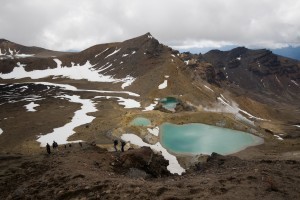 Our plane descends through the clouds and land becomes visible beneath the wings. Great swaths of trees and houses fall away as the plane banks and turns towards the airport. The windows tilt to the sky and the sun spikes in, causing passengers to lower their window shades. I swallow and close my eyes, my brain fuzzy from jet lag and lack of sleep. I’m here on little more than a whim; tired of working a lackluster job, I picked a place I’d always wanted to visit and told my job I was quitting. Several months later, my obligations left behind, I boarded a plane to New Zealand. Now here I am, touching down on the tarmac in a foreign country I know little about. I only perused the guidebooks halfheartedly in the months before my departure. I’m not sure what made me shy away from learning all I could about this country. Perhaps I’m afraid of my own judgements of a place or afraid that once I learn all the facts, the magic will be gone. I get off the plane feeling exhausted but excited at all that lies before me.
Our plane descends through the clouds and land becomes visible beneath the wings. Great swaths of trees and houses fall away as the plane banks and turns towards the airport. The windows tilt to the sky and the sun spikes in, causing passengers to lower their window shades. I swallow and close my eyes, my brain fuzzy from jet lag and lack of sleep. I’m here on little more than a whim; tired of working a lackluster job, I picked a place I’d always wanted to visit and told my job I was quitting. Several months later, my obligations left behind, I boarded a plane to New Zealand. Now here I am, touching down on the tarmac in a foreign country I know little about. I only perused the guidebooks halfheartedly in the months before my departure. I’m not sure what made me shy away from learning all I could about this country. Perhaps I’m afraid of my own judgements of a place or afraid that once I learn all the facts, the magic will be gone. I get off the plane feeling exhausted but excited at all that lies before me.
The original plan was to stay in New Zealand for a year, taking jobs around the country in order to offset my food and lodging costs. I soon discovered that this was not going to happen. There was something magical about those islands, something that grabbed me and refused to let me stay in one place for very long. I didn’t want to waste a moment scrubbing kitchen ceilings when I could be trekking over mountains or kayaking across bays. By settling in a place and strapping myself into a routine, I knew I’d be closing myself off to the magic of serendipity that a solo traveler enjoys. How could I wake up in a warm seaside town one morning and adjacent to a glacier the next if I had to launder fifty sets of bedsheets and clean an entire hostel? I threw all but my basic itinerary in the trashcan and headed to the nearest pub. I had a vacation to enjoy.
The three months that followed were some of the most enjoyable of my life. Each day I woke up with a wide array of possibilities before me, the only obligations those of feeding and clothing myself and remembering where I was sleeping that night. I hiked the Tongariro Crossing, my knees shaking on the endless vertical switchbacks and my shoes filling with gravel as I skidded down the side of a glacial crater. I trudged through emerald-green valleys filled with sheep, listening to the strange birdcalls that filled the air. Sometimes I called back. I tied crampons to my hiking boots and climbed up a glacier, the glowing whitish-blue of the ice a stark contrast to the dark rock surrounding it. Donning a wetsuit and a helmet, I rappelled into a cave to explore an underground river. Glow worms hung from the ceiling above me, making constellations of their own in the subterranean sky. I made friends on ferries and in buses, danced in clubs and slept under the stars. I was free.
After three months of hiking, sightseeing, kayaking, caving, sunbathing and jumping out of one perfectly good plane, I ran out of money and had to return home. Exhausted, I fell asleep the minute I boarded the plane and slept through most of the flight back to California. When asked what my favorite thing about my trip had been, I didn’t know what to day. I listed hikes and adrenaline-packed activities but in my heart I knew that the best thing about the trip had been opening myself fully to the strangeness of a new country. When we release ourselves from the constraints of our routinely scheduled lives, we leave ourselves open to happenstance, to serendipity, and to magic. How else could I explain my wanderlust besides an opportunity to cast off the shackles of routine and expectation and truly just be myself? New Zealand was the first place to show that to me, and I’m confident it won’t be the last.
About the Author: Ravina Schneider is a snarky brunette who likes to cook almost as much as she likes to travel. Sometimes she does both at once. She grew up in Northern California, traveling with her parents to Europe for the first time at the age of 9. She has been to seven countries and nearly every state in the U.S since then.
Thank you for reading and commenting. Please enter our next Travel Writing competition and tell your story.
The post Embracing Serendipity in New Zealand appeared first on We Said Go Travel.
We Said Go Travel
We Said Go Travel is a global community of over sixteen hundred writers with articles from every continent.
Stories are shared with photos and video from a perspective of the transformative power of travel. We Said Go Travel has hosted live and online events as well as travel writing contests around the world. ...more
- Lisa Niver's profile
- 57 followers


